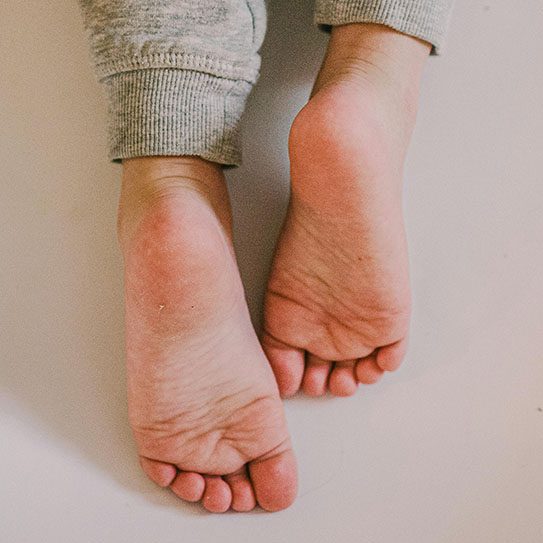
In-toeing, commonly known as “pigeon toes,” is a condition where a child’s feet turn inward when walking. It’s a common sight in pediatric offices, and many parents worry about whether this will affect their child’s ability to run, walk, or play sports. Let’s delve into what causes in-toeing, the various types, and when, if at all, you should be concerned.
Understanding In-Toeing in Children
In-toeing can manifest at different stages of a child’s growth, due to different underlying conditions:
- Metatarsus Adductus: Noticed from birth, this condition involves the front part of the foot turning inward. It often corrects itself, particularly within the first few years of life with walking.
- Tibial Torsion: This is when the shinbone twists inward and is usually noticed when a child begins walking.
- Femoral Anteversion: This involves the inward turning of the thigh bone and is typically observed in children aged 3 to 10 years.
Causes and Developmental Concerns
The causes of in-toeing are varied but are often related to the position of the baby in the uterus or genetic factors, as these conditions can run in families. While metatarsus adductus, tibial torsion, and femoral anteversion may sound alarming, they rarely prevent children from learning to walk, run, or play as other kids do.
Metatarsus Adductus
Imagine the outer edge of your child’s foot forming a crescent moon shape — that’s metatarsus adductus. It varies from barely noticeable to more obvious cases where the foot is quite bent. When it’s severe, and the foot is stiff or coupled with other issues like clubfoot (a more distinct curve of the foot), doctors might suggest using casts or special boots early on to help straighten things out.
Tibial Torsion
This one involves the shinbone and might look like your child’s toes turn inwards a bit. The good news? It usually fixes itself as your child grows up. No fancy shoes, braces, or surgery needed — just time and natural growth.
Femoral Anteversion
If you see your child often sitting in a “W” shape — knees bent and feet splayed out to the sides — that’s a clue they might have femoral anteversion. It sounds complicated, but it’s just a fancy way of saying their thigh bone turns inward a bit. Like with tibial torsion, this typically gets better on its own as kids get taller and their bodies mature.
For all these conditions, most kids grow out of them naturally. Keeping an eye on how your child walks and plays is smart, but these common twists and turns often don’t need us to do much but provide time for growth and natural correction. If something seems off or isn’t improving, that’s the time to chat with a pediatric orthopedist who can guide you on the best steps to take.
When to Seek Treatment
Here’s a simple guideline on when to consider seeking advice from a pediatric orthopedist:
- Under 6 Months: Observation is usually recommended as many infants naturally outgrow mild forms of in-toeing.
- 6 to 9 Months: If the condition is severe or the feet are rigid, treatment such as casting might be necessary.
- Early Childhood: Persistent in-toeing in older children can occasionally lead to problems such as tripping or an awkward gait. If these issues are significant, and your child is near or has passed their 9th birthday without improvement, consult with a specialist.
Common Myths and Misconceptions
It’s important to address some common misconceptions about treating in-toeing:
- Corrective Shoes and Braces: These are often marketed as solutions but have not been proven effective and could interfere with normal childhood activities.
- Surgery: While rarely necessary, surgery might be considered in persistent and severe cases that affect the child’s mobility or cause other complications.
Psychological and Emotional Considerations
The social and emotional impacts of wearing corrective devices should not be underestimated. Children may feel different from their peers, which can affect self-esteem and social interactions. Therefore, the decision to use such devices should be made with caution and compassion, considering both the physical and emotional well-being of the child.
The Experts Are Here to Help
In most cases, in-toeing is a part of normal childhood development that corrects itself over time without the need for intervention. However, it’s crucial for parents to monitor their child’s progress and seek professional advice if the condition persists or causes functional problems. Remember, the goal of any treatment should be to support your child in growing up healthy and active, without unnecessary interventions that could impede their natural development.
At Pediatric Orthopedic Specialists in Park City, UT, we’re here to support you with expert advice and care to ensure your child thrives at every step of their development. If you have concerns about your child’s in-toeing, don’t hesitate to reach out for guidance.

